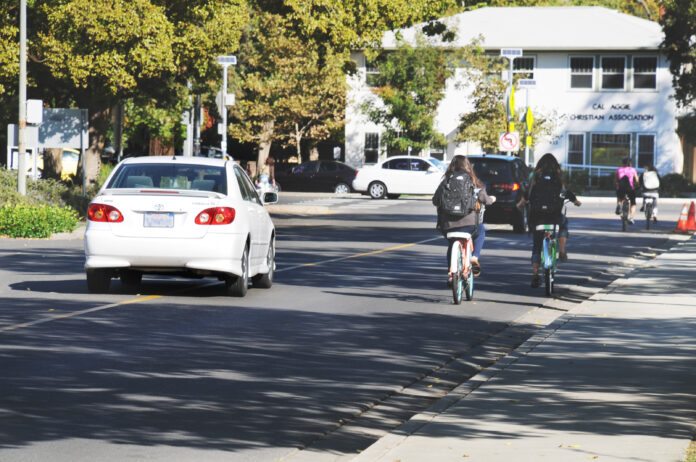On Sept. 23, Gov. Jerry Brown signed Assembly Bill (AB) 1371, the “Three Feet for Safety Act,” into California Law. The bill, authored by Assembly Member Steven Bradford (D-Gardena) would require motorists to give bicyclists a mandatory three feet cushion on all roads. AB 1371 will go into effect Sept. 16, 2014.
“I sincerely thank the governor for signing this commonsense measure to protect cyclists on our roads … When cars and bikes collide, it often turns to tragedy,” Bradford said in a press release. “This bill is a great reminder that we all have to work together to keep our roads safe for all users.”
Failing to comply with the three feet clearance would result in a $35 base fine, with extra fees increasing the fine to $154. Additionally, if a motorist collides with a cyclist and injures them, the fine would be $220, according to Bradford’s spokesperson Matt Stauffer.
“Once you get hit you now have remedies in the court system. The intent is to make the roads safer … some people had concerns that it is too hard to measure three feet while you’re driving. It’s going to come down to a case by case scenario,” Stauffer said.
Similar bills have failed to pass five times. While this is the first time Bradford has carried the bill, other members have carried similar ones before. The bills died twice before during the legislative process; this was the third time the bill got to Governor Brown.
“Previous versions gave explicit permission to cross a double yellow in order to provide three feet of space. [Governor Brown] had concerns about liability if an accident were to occur,” Stauffer said.
In AB 1371, they took out specific references regarding both the double yellow line and the speed limit in order to make a safer bill.
“Caltrans had concerns that if people are slowing down then the drivers behind them might run into them — there’s a lot of liability,” Stauffer said.
According to the National Highway Safety Administration in the U.S. Department of Transportation, 677 pedal cyclists were killed in 2011. 48,000 cyclists were injured that same year, constituting two percent of people injured in car accidents and marking a nine percent increase in injuries from 2010.
“I think that [the “Three Feet for Safety Act”] is going to be very critical. It will make people more aware and particularly make law enforcement people have a regulation that they don’t have to interpret,” said John Waterson, a member of the Davis Bicycle Advisory Commission. “It will be clearer that the bikes are to have that three foot buffer so that people will not fear for their safety while biking.”
Similar laws are in effect in 22 other states. Most states require a three foot clearance, though Pennsylvania requires four.
“We’re not doing anything radical and untested, other states have done this before. I could not speak to the data but I’m not aware that they have had problems implementing or complying with the law,” Stauffer said.
Davis Bicycle Advisory Commission member Darell Dickey said that he believes that though this bill has many benefits it won’t have a radically changing effect on the safety of bicyclists.
“It gives cyclists a tool when something does go wrong to get some restitution. When a car hits a cyclist, it’s very hard to prove [the] car guilty in court … but in general, I don’t think it’s going to change anything except I suppose [more reports] could be made,” Dickey said. “There are very few cyclists that know what laws pertain to them.”
Even with the new “Three Feet for Safety Act,” commissioners still see room for improvement in Davis regarding bicycle safety.
According to Dickey, the single most important thing is for the City of Davis to make rules that pertain to cyclists rather than having cyclists follow rules meant for motorists.
“One side is to remove bikes off the road to get them out of the traffic and then you don’t have to have stop signs every block and traffic lights every two blocks,” Dickey said. “Other countries have managed to do it. Davis is a phenomenal place to ride a bike compared to other more urban cities, but at the same time [it] has a long way to go.”
The Davis Bicycle Advisory Commission has been working in advising the Davis mayor. The main priority has been to uphold Davis values as a bicycle-friendly town by moving toward ensuring “complete streets now,” to make it safe for kids to bike to school, making bicycle parking convenient and having wider roads among other tactics to maintain the “bicycle connectivity.”
“As much as we pride ourselves as being bicycle-friendly, we are almost a completely car-centric town. I’d like to prioritize bikes and consider them first or equal to cars,” Dickey said. “When new infrastructure goes in, it’s all made for cars and we fit in the bikes around when we should be making all roads more bicycle friendly.”
GABRIELLA HAMLETT can be reached at city@theaggie.org.






[…] California Aggie, “new California law to increase safety for bicycles“, Gabriella Hamlett, October 03, […]